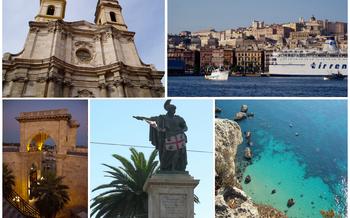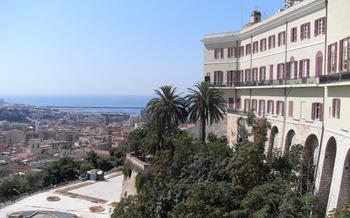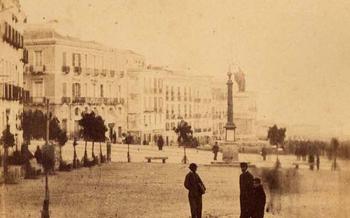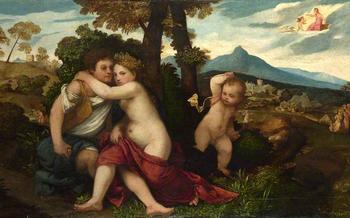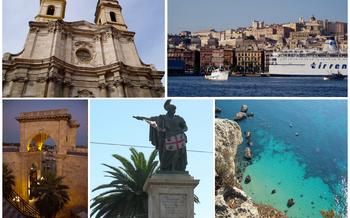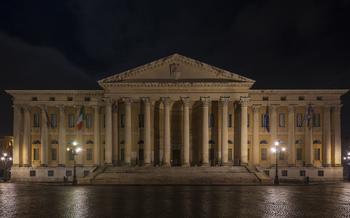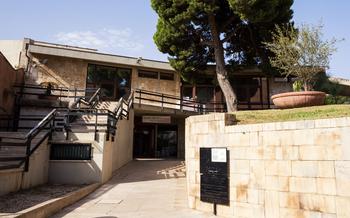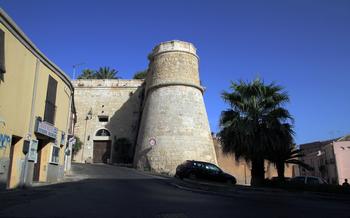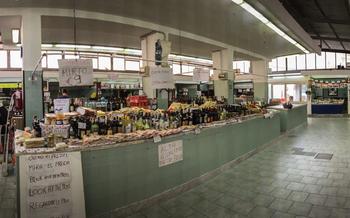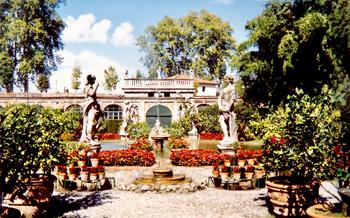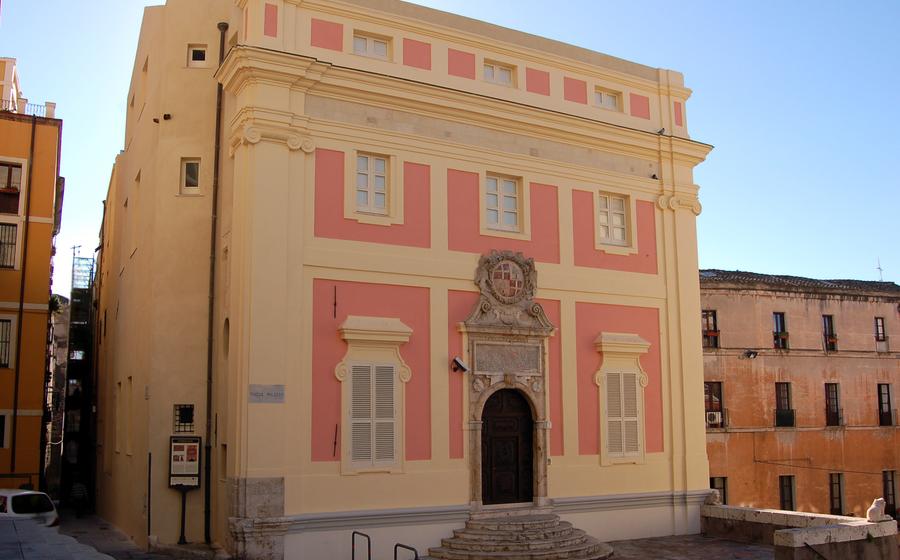
Palazzo di Città
- A Glimpse into Cagliari's Rich History: Exploring the Palazzo di Città
- History and Architecture
- Historical Significance
- Guided Tours
- Highlights of the Interior
- Piazza Palazzo: The Heart of Cagliari's Civic Life
- Changing of the Guard Ceremony
- View from the Bell Tower
- Events and Exhibitions
- Practical Information
- Admission and Tickets
- Photography and Social Media
- Accessibility and Transportation
- Insider Tip
A Glimpse into Cagliari's Rich History: Exploring the Palazzo di Città
In the heart of Cagliari, a city pulsating with history and Sardinian charm, stands the Palazzo di Città, a majestic edifice that exudes both architectural grandeur and historical significance. This iconic building, which serves as the seat of the local government, has witnessed the ebb and flow of time, encapsulating within its walls the spirit of a city that has proudly preserved its heritage while embracing modernity.
As you approach the Palazzo di Città, its imposing facade, adorned with intricate carvings and elegant arches, commands attention. Step inside, and you'll be transported back in time, surrounded by opulent halls, grand staircases, and priceless artworks that narrate the rich tapestry of Cagliari's past.
The Palazzo di Città is not just a building; it is a living testament to the city's resilience, its triumphs, and its aspirations. Within its walls, decisions are made, policies are shaped, and the future of Cagliari is charted. It is a place where history echoes in every corner, where the past and present converge, and where the spirit of Sardinia shines brightly.
History and Architecture
The origins of the Palazzo di Città date back to the 13th century when it was built as a fortified palace by the Pisans, who ruled Cagliari at the time. Over the centuries, the building underwent several renovations and expansions, reflecting the changing political and cultural influences in the city. In the 15th century, the Aragonese rulers added a Gothic tower to the palace, while the Spanish Habsburgs introduced Renaissance elements during their rule in the 16th century. The most significant transformation occurred in the 18th century when the Savoy dynasty commissioned a major reconstruction of the palace, giving it its current neoclassical façade.
The Palazzo di Città is a harmonious blend of architectural styles, showcasing elements from the Middle Ages, Renaissance, and Baroque periods. The exterior is characterized by its imposing façade featuring a portico with Doric columns and a triangular tympanum. The interior is equally impressive, with a grand staircase, elegant halls, and ornate chambers adorned with frescoes, stuccoes, and intricate carvings. Notable features include the Sala del Consiglio, a grand council chamber with a coffered ceiling and a large fireplace, as well as the Sala degli Specchi, a magnificent ballroom with mirrored walls and crystal chandeliers.
Historical Significance
The Palazzo di Città has played a pivotal role in shaping Cagliari's history and identity. Constructed in the 14th century, it has witnessed and housed significant events that have left an indelible mark on the city. The building served as the seat of Cagliari's municipal government for centuries, hosting crucial meetings, debates, and decisions that shaped the city's destiny. It was within these walls that local leaders navigated political, economic, and social issues, laying the foundations for Cagliari's development and prosperity.
During the Aragonese and Spanish rule, the Palazzo di Città became a symbol of royal authority. It was here that monarchs and their representatives received dignitaries, conducted official business, and administered justice. The palace's grand halls and chambers echoed with the footsteps of history, as royal edicts were issued, alliances were forged, and disputes were resolved. The building's strategic location in the heart of Cagliari further cemented its significance, as it became a focal point for public gatherings, celebrations, and protests.
Over the centuries, the Palazzo di Città has endured wars, sieges, and transformations, emerging as an enduring testament to Cagliari's resilience. Its intricate architecture, rich history, and continuous use as a seat of governance make it a tangible link to the city's past, present, and future.
Guided Tours
Guided tours of the Palazzo di Città offer visitors a deeper insight into the history, architecture, and significance of this iconic building. Conducted by knowledgeable guides, these tours typically cover the highlights of the palace, including the grand entrance hall, the Council Chamber, the Mayor's Office, and the Sala dei Matrimoni (Wedding Hall). Visitors will learn about the different stages of the Palazzo's construction, the notable historical events that have taken place within its walls, and the artistic treasures that adorn its interior.
Tours are available in multiple languages, including English, Italian, French, and German, and are offered on a regular basis throughout the week. Advance reservations are recommended, especially during peak tourist season, to secure a spot and avoid long wait times. The tours usually last for about an hour and provide an excellent opportunity to appreciate the architectural details, admire the artwork, and gain a deeper understanding of the role that the Palazzo di Città has played in the history of Cagliari.
Highlights of the Interior
Within the Palazzo di Città, visitors can marvel at a treasure trove of artistic masterpieces and architectural wonders. Notable rooms and chambers include the grand Sala Consiliare, where official council meetings are held, and the Sala dei Matrimoni, a majestic hall adorned with intricate frescoes and elegant chandeliers, where civil ceremonies take place.
The building's walls are adorned with priceless paintings by renowned Sardinian and Italian artists, depicting scenes from history, mythology, and everyday life. Among the highlights are the striking "The Martyrdom of Saint Efisio" by Giovanni Angelo Bazzi, known as Sodoma, and "The Triumph of the Madonna" by the Cagliari-born artist Giuseppe Biasi.
Visitors can also admire a collection of sculptures, busts, and statues that grace the palace's interior. These works of art, crafted from marble, bronze, and other materials, showcase the skill and artistry of local and international sculptors.
Piazza Palazzo: The Heart of Cagliari's Civic Life
The Palazzo di Città stands proudly at the heart of Piazza Palazzo, a historic square that has been the center of Cagliari's civic and social life for centuries. This elegant and spacious plaza is a testament to the city's rich history and architectural heritage, providing a glimpse into Cagliari's past and present.
Surrounding the Palazzo di Città are several notable landmarks that contribute to the square's significance. The Gothic-style Church of San Pancrazio, with its intricate facade and soaring bell tower, stands as a symbol of Cagliari's deep-rooted religious traditions. The Palazzo Regio, once the seat of the Sardinian parliament, now houses the city's Archaeological Museum, showcasing a fascinating collection of artifacts from the island's ancient past.
Piazza Palazzo has been a gathering place for locals and visitors alike throughout the centuries. The square hosts a variety of events, from traditional festivals and markets to political rallies and cultural performances. The lively atmosphere and vibrant energy of Piazza Palazzo make it a must-visit destination for anyone seeking to experience the true essence of Cagliari.
Changing of the Guard Ceremony
The Palazzo di Città is not just a historic building but also a living witness to Cagliari's vibrant traditions. One of the most captivating spectacles that take place here is the changing of the guard ceremony, a time-honored ritual that symbolizes the continuity of civic authority and pride.
Every day, at precisely 11:00 AM, the courtyard of the palace comes alive with the rhythmic cadence of marching footsteps. A detachment of the Guardia di Finanza, Italy's elite financial police, emerges from the building, their uniforms resplendent in midnight blue and gold. With impeccable precision, they form ranks, their gleaming helmets and polished bayonets reflecting the sunlight.
The ceremony is steeped in symbolism and tradition. The changing of the guard represents the peaceful transition of power and the unwavering commitment to upholding law and order in the city. As one contingent of guards marches out, another marches in, perpetuating a cycle of vigilance and service.
Visitors to Cagliari are encouraged to witness this mesmerizing spectacle, which offers a glimpse into the rich heritage and living traditions of the city. The changing of the guard ceremony is a reminder of the enduring role that the Palazzo di Città plays in the daily life and identity of Cagliari.
View from the Bell Tower
The Palazzo di Città's iconic bell tower is not just a decorative element but also a vantage point from which to admire breathtaking views of Cagliari and its surroundings. Accessible to visitors through guided tours, the tower offers a unique perspective on the city's historical center and the Gulf of Angels. From the top, visitors can spot notable landmarks such as the Basilica di San Saturnino, the Torre dell'Elefante, and the Castello di San Michele, all set against the backdrop of the sparkling blue Mediterranean. The panoramic vistas extend beyond the city limits, encompassing the Sella del Diavolo mountain range and the distant Capo Carbonara promontory. The climb to the bell tower is well worth the effort, as it provides a comprehensive overview of Cagliari's rich history and natural beauty.
Events and Exhibitions
The Palazzo di Città is not only a symbol of civic authority but also a vibrant cultural hub. Throughout the year, it hosts a diverse range of cultural events, exhibitions, and initiatives that cater to the interests of both locals and visitors.
Art enthusiasts can immerse themselves in temporary exhibitions showcasing the works of renowned artists, both from Italy and around the world. The palace's grand halls and chambers provide a majestic backdrop for these displays, enhancing the overall experience.
In addition to art exhibitions, the Palazzo di Città also hosts cultural events and initiatives that celebrate the rich heritage and traditions of Cagliari. These events may include historical reenactments, traditional music performances, literary readings, and workshops.
To stay informed about upcoming events and exhibitions, visitors can check the official website of the Palazzo di Città or follow its social media channels. By attending these events, visitors can gain a deeper insight into the cultural fabric of Cagliari and experience the palace's vibrant atmosphere firsthand.
Practical Information
Address, Contact Details, and Website:
The Palazzo di Città is located in the heart of Cagliari, at Piazza Palazzo Its central position makes it easily accessible by foot or public transportation. For more information, visitors can refer to the official website of the city of Cagliari or contact the tourism office at +39 070 6777000.
Accessibility for Visitors with Disabilities:
The Palazzo di Città is wheelchair accessible, with ramps and elevators providing access to all floors of the building. Visitors with disabilities are encouraged to contact the tourism office in advance to arrange for any special assistance or accommodations.
Tips for Visiting During Peak Tourist Season:
To avoid crowds and long queues, it is advisable to visit the Palazzo di Città during the shoulder seasons (spring and autumn) or during the winter months. Visitors should also consider visiting early in the morning or late in the afternoon to experience a quieter and more intimate atmosphere.
Admission and Tickets
Visiting the Palazzo di Città is a relatively affordable experience, with entrance fees varying depending on the type of ticket purchased. A standard admission ticket grants access to the main halls and exhibits, while a combined ticket includes entry to the Palazzo di Città and other attractions in Cagliari. Discounted rates are available for students, seniors, and families, and advance booking online is recommended to avoid queues during peak tourist season.
For those seeking a more immersive experience, guided tours are available in several languages, providing insights into the history, architecture, and significance of the Palazzo di Città. Guided tours typically cover the highlights of the interior, including the grand staircase, the Council Chamber, and the Mayor's Office. Visitors are advised to check the official website or inquire at the ticket counter for tour schedules and availability.
Photography and Social Media
Photography enthusiasts should take note of the guidelines and restrictions when capturing images inside the Palazzo di Città. While photography is generally permitted in most areas of the building, the use of flash or tripods may be prohibited in certain rooms or exhibitions to preserve the artwork and artifacts. It's essential to be respectful of these rules and avoid disturbing other visitors or disrupting ongoing events.
Embrace the opportunity to share your experiences online by using social media platforms to document your visit to the Palazzo di Città. Share captivating photographs, engaging stories, and interesting facts about the building's history and significance. Don't forget to use relevant hashtags like #PalazzodiCittaCagliari and #CagliariHistory to connect with other travelers and history buffs worldwide. Geotagging your posts will also help promote the palace and encourage others to explore this cultural gem.
Accessibility and Transportation
Reaching the Palazzo di Città is a breeze, thanks to the efficient public transportation system in Cagliari. The bus network provides several lines that stop within walking distance of the palace, making it easily accessible from different parts of the city. Alternatively, visitors can hop on the handy tram line, which offers a scenic ride along the city's main thoroughfares and has a stop right next to the building.
For those arriving by car, ample parking options are available in the vicinity of the Palazzo di Città. The nearby pay-and-display parking lots offer convenient short-term parking solutions, while the underground parking garage provides a secure option for longer stays.
Once you've arrived at the Palazzo di Città, you'll find it strategically situated within easy reach of other notable attractions in Cagliari. The vibrant Piazza Palazzo, with its lively cafes and shops, is right at your doorstep. From there, you can easily explore the medieval district of Castello, visit the Elephant Tower, or wander through the narrow streets lined with boutiques and art galleries. The Palazzo di Città is a perfect starting point for a day of sightseeing and cultural immersion in Cagliari.
Insider Tip
For a quieter and more intimate experience, consider visiting the Palazzo di Città early in the morning before the crowds arrive. This will allow you to immerse yourself in the grandeur of the building without the hustle and bustle of tour groups. Additionally, take some time to explore the hidden courtyards and gardens within the palace, where you can find moments of tranquility amidst the historic walls.
One secret spot worth seeking out is the small chapel located on the upper floor of the building. This hidden gem is often overlooked by visitors but offers a glimpse into the religious history of the palace. Lastly, be sure to ask a local about the legend of the "Ghost of the Palazzo." They may share a tale of a mysterious apparition that is said to haunt the halls of this historic building.
